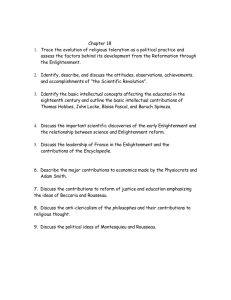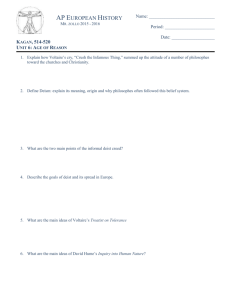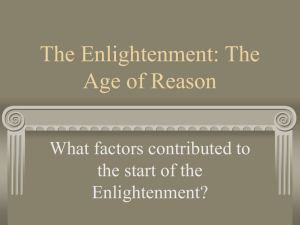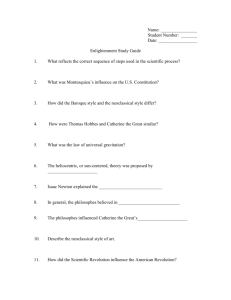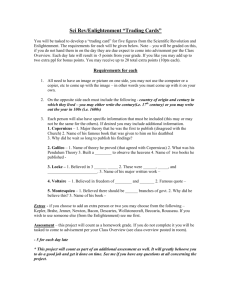2011 Defining the Age of Enlightenment and Five Key Ideas Lesson
advertisement
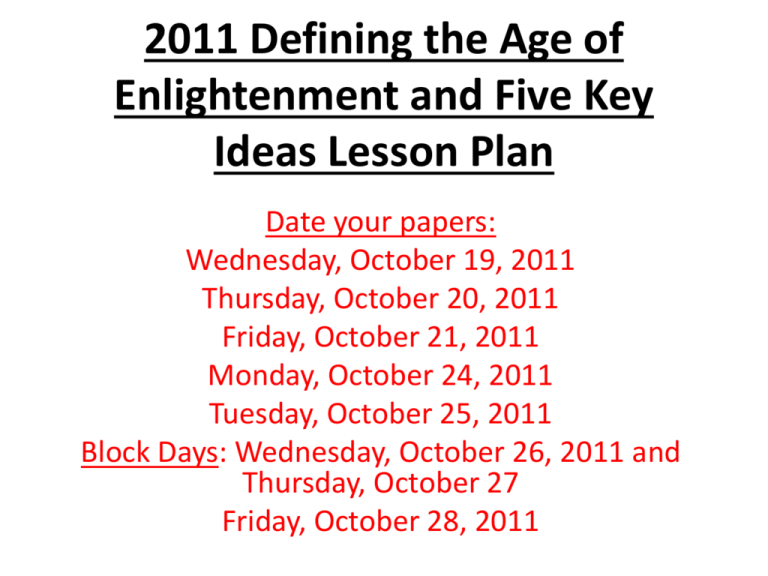
2011 Defining the Age of Enlightenment and Five Key Ideas Lesson Plan Date your papers: Wednesday, October 19, 2011 Thursday, October 20, 2011 Friday, October 21, 2011 Monday, October 24, 2011 Tuesday, October 25, 2011 Block Days: Wednesday, October 26, 2011 and Thursday, October 27 Friday, October 28, 2011 • Essential and Guiding Questions: • How did the Philosophes apply the techniques of the Scientific Revolution to explain/study society? • Did the Renaissance, Reformation, Scientific Revolution, and Enlightenment completely eliminate the “old world”? • How did the Philosophes challenge the role of government? • According to the Philosophes, what was the purpose of society? • What was the role of religion in most nations during the Enlightenment? Wednesday, October 19, 2011 • Quiet Question: Type One Prompt---Examine ONE of the six Visual Primary Sources from the Age of the Enlightenment, and complete the Picture Analysis Questions in the lesson plan. • Pair-Share: Turn to your partner and share your Picture Analysis. After doing that, look over the three historical images with your partner, and based upon your impressions of the three images, what are your predictions for what the Age of Enlightenment was about and like. Do these in the space below: • Images • Predictions Explanations Wednesday, October 19, 2011 • Class: As a class, we will share and discuss the predictions. Ms. Barben will introduce the Age of Enlightenment. As Ms. Barben reads aloud the short introduction, highlight key points. • Class: We are going to watch the Age of Enlightenment Video. – As we do, you are to complete the 5 W Chart on the Age of Enlightenment. – Identify the key ideas and related events in the Five Ws and How Organizer. Wednesday, October 19, 2011 • Homework: This reading assignment has two parts: 1. Textbook Pages: – – – – – – – “Causes of the Enlightenment”: pages 538-545 “Path to the Enlightenment”: page 546 ONE PARAGRAPH---Stop at John Locke “Europe and the Age of Enlightenment Map” ONLY: page 547 “The Growth of Reading and the Salon”: pages 552-553 “Social History: The 18th Century Salon”: pages 564-565 Take traditional notes on either Post-Its or a separate piece of paper. Make sure to pay attention to inset maps and images. 2. Photocopied Supplemental Reading: You are to Talk to the Text on the yellow supplemental reading “The Age of Enlightenment” and flowcharts – Highlight no more than 20% of the content • For the Talking to the Text, you must: – – – – Have a minimum of THREE well-developed responses per page. The responses must explain why and not be a few words. You must respond to visuals, flowcharts, inset boxes of information, etc… You must use at least FIVE types of responses . Wednesday, October 19, 2011 • In your Assignment Book, “chunk” or breakup the reading assignment by days for each day it is the homework until it is due. • Textbook Pages: – Wed and Thursday: DAY ONE and DAY TWO HOMEWORK: “Causes of the Enlightenment”: pages 538-545 – All Friday: DAY THREE HOMEWORK: “Path to the Enlightenment”: page 546 ONE PARAGRAPH---Stop at John Locke – DAY THREE HOMEWORK: “Europe and the Age of Enlightenment Map” ONLY: page 547 – DAY THREE HOMEWORK: “The Growth of Reading and the Salon”: pages 552553 – DAY THREE HOMEWORK: “Social History: The 18th Century Salon”: pages 564-565 • Photocopied Supplemental Reading: – Monday: DAY FOUR HOMEWORK: “The Age of Enlightenment” stopping at “The Political and Economic Background” – Tuesday: DAY FIVE HOMEWORK: “The Political and Economic Background stopping at “Deism” – Tuesday DAY FIVE HOMEWORK: “Deism” through the Four Flowcharts Thursday, October 20, 2011 • Class: We are going to finish the Age of Enlightenment Video. You are to finish the Five Ws and How Organizer. • • Pair-Share: Turn to your partner and compare and contrast your video notes. Add and revise. Then you and your partner are to do a “Sum It Up”. • Directions for “Sum It Up”: – Using both your Video Web Charts, list the MAIN IDEAS about the Age of Enlightenment. • – Now you will write a summary of the Age of Enlightenment. You are to use as many of the MAIN IDEAS WORDS as possible. But you cannot exceed 20 WORDS. • Thursday, October 20, 2011 • Class: Pairs will share their Age of Enlightenment “Sum It Ups”. Ms. Barben will answer any questions they have at this point. • Homework: Continue reading assignment. Friday, October 21, 2011 • Quiet Question: Type Two Prompt---Write a 5 W Poem on the Age of Enlightenment using your Age of Enlightenment Video Notes and textbook pages. • Format: • Who? (One Noun) • What? (Action Phrase) • When? (Time Phrase) • Where? (Place Phrase) • Why? (Explanation) Friday, October 21, 2011 • Pair-Share: Turn to a different partner than the one you did the “Sum It Up” with and read each other’s 5W Poem. Give feedback and write down any questions. • • Class: As Ms. Barben does her Defining the Age of Enlightenment PowerPoint Presentation, you are to take notes in the provided graphic organizer. Please pay attention to how and what you will be taking note: • • Definitions/Beliefs: This includes the formal definitions, key defining characteristics, and related causes and effects. • Examples: This includes examples of new ideas, key people, or events related to the definitions or beliefs. • Symbols: These are symbols or pictures that help you remember the HISTORICAL DEFINITIONS. It is best to do this in color to help you remember. • Effects: Here you identify all the effects that the Enlightenment had on Europe and America. • *****It is very important to take good notes for all three parts as we will be using this information for a Group Project and for the Homework. Friday, October 21, 2011 • Homework: Your reading assignment Monday, October 24, 2011 • Class: Ms. Barben is going to finish her PowerPoint Presentation, and you are to continue taking notes in the provided graphic organizer. • Homework: Your reading assignment Tuesday, October 25, 2011 • Groups: As a way to check for understanding and review what the Age of Enlightenment was all about, in your assigned groups, you will be creating a Pictoword for ENLIGHTENMENT. • • A Pictoword or Sociogram uses images related to the word to form the shapes of each letter. • As you shape-spell out the word, you are also defining the word and providing examples of what the word is all about. • You may have done this in middle school as one of your art projects. • Ms. Barben has examples posted around the room and will also show examples on the Smartboard. • There are also examples uploaded on her Teacher Page. • You will use your graphic organizer notes, the textbook, and supplemental reading for this activity. Tuesday, October 25, 2011 • • • • • • • • • • • • • • • • • • • • • • • • a) The student used pictures, symbols, and images to form the shape of each letter. The student did not just outline the letter and stick pictures to it. And the images spell out---ENLIGHTENMENT b)The images each defined a different aspect of the ENLIGHTENMENT-That means 13 different characteristics. No concepts or images were repeated. If an image or aspect is repeated, it will not be counted. You may use computer images from Ms. Barben’s PowerPoint, the internet, or hand-draw them. Must address: causes of the Enlightenment, definition of the Enlightenment, the five key ideas of the Enlightenment----reason, nature, liberty, happiness, and progress, philosophes, and effects of the Enlightenment Each image/letter is worth 5 points for a total of 65 points c) There was a detailed TYPED key that explained the symbolism for each letter. The key was well-developed and served as a good review of the notes from all sources---textbook, supplemental readings, and powerpoint. Each key description was a minimum of THREE well-developed sentences that defined, explained, and provided examples. Each letter with key explanation is worth 5 points for a total of 65 points. d) The assignment was done in color, neat, and reflected good effort. If not, it is 10% off. On Pictoword Grade Sheet • Each group member must write down on the back what he or she specifically did. • We have had issues of students not carrying their weight in group projects, and this will not happen again. • If you do not do your fair part, you will not receive credit for the project and will receive a zero! Tuesday, October 25, 2011 • Homework: Your reading assignment Block Days • Ms. Barben is going to collect your reading assignment. Make sure: • • Staple your Grade Sheet to the top. Make sure your name is on the Grade Sheet. • Behind the Grade Sheet should be your Textbook Notes on Post-Its or on paper. • The last part is the yellow supplemental reading that you Talked to the Text to. • Groups: You will have the the class period to finish up your Enlightenment Pictoword. Presentations are on Friday, a regular day schedule. Block Days • Class: Groups will present their Enlightenment Pictowords. As the groups present, add or revise your notes in the graphic organizer. • • Homework: You are going to create Vocabulary Cards on the terms of the Enlightenment. They are due on:________________________. • Project Summary: To demonstrate knowledge in a field, one must be able to use the vocabulary of that field, but your textbook introduces vocabulary a little at a time and then doesn’t review it. • Writer’s Purpose: • You will create clear information, with accurate definitions of important concepts or words. • You will provide an official definition and then paraphrase the definition applying the historical context you were exposed to with the term. • You will also provide historical and current examples that are relevant to you to help you define the word and make connections to related concepts. • In addition, you will write a sentence using each vocabulary word that will help you remember the word and its meaning. • And then a graphic or visual will be provided to help activate that part of learning and memory. • Block Days • Writer’s Role: You will be writing as yourself, a concerned student who sees this assignment as a relatively easy way to get a good grade and produce something that will help you learn. • Audience: You will be creating these cards primarily for your own use to study for the unit test and midterm. • Form: On your card, you should have the following--– Word spelled correctly – Historical definition---From Enlightenment Time Period—use notes and supplemental reading---DO NOT JUST GET A DEFINITION FROM THE DICTIONARY! Dictionary definitions are NOT HISTORICAL DEFINITIONS. – Historical Examples From Enlightenment Time Period---use your textbook, notes, and supplemental reading – Related Words like synonyms or antonyms – Original Sentence using word in historical context – Historical graphic/illustration in color Block Days • Focus Correction Areas: • FCA One: Min. of Eight cards with word, historical definition, and personal definitions with historical examples---Worth 60 points. • FCA Two: Complete, original sentence that conveys the historical meaning of the word---Worth 20 points. • FCA Three: Relevant historical picture or illustration that can be hand-drawn or computer generated in color---Worth 15 points. • No Excuses: Self-Edited Rough Drafts for at least 5 out of the 8 vocabulary cards, TYPED, and spell-checked---Worth 5 points. • • Rough Drafts: • You are to create rough drafts for your FIVE of the required EIGHT. • A rough draft means notes for each required point and an idea for your image…can for a word. Block Days • • • • • • • • • • • • • Vocabulary Card Topics: Enlightenment Philosophes Secular Reason Nature Liberty Happiness Progress Deism Natural Law Social Contract Salons Friday, Oct 28, 2011 • Class: Groups will present their Enlightenment Pictowords are review. – You should be double-checking your notes. – Revising your notes. – Adding information to your notes. Friday, Oct 28, 2011 • Rest of Class and Homework: Work on your Enlightenment Vocabulary Cards
